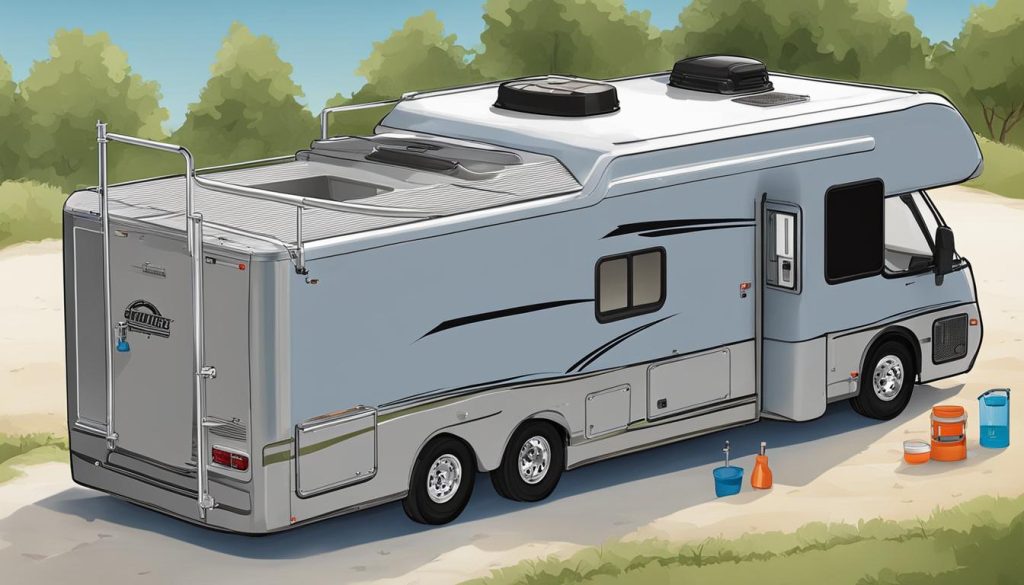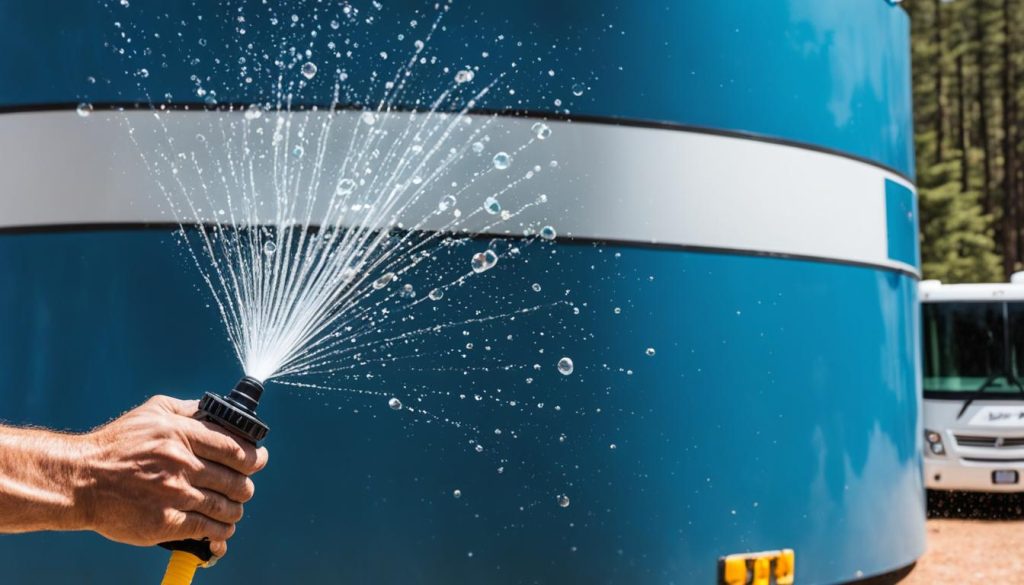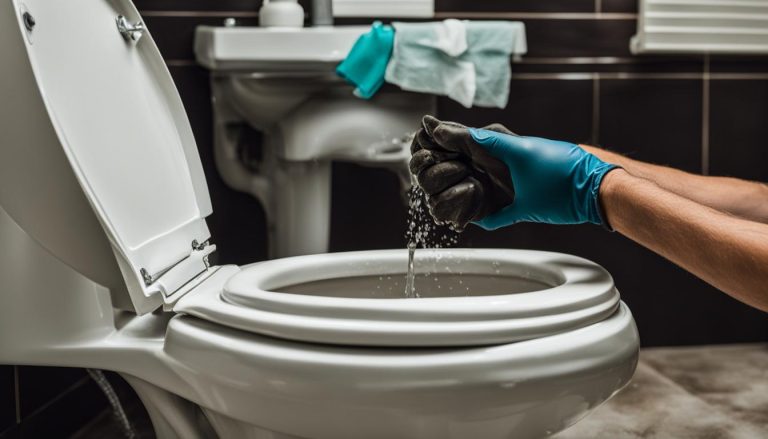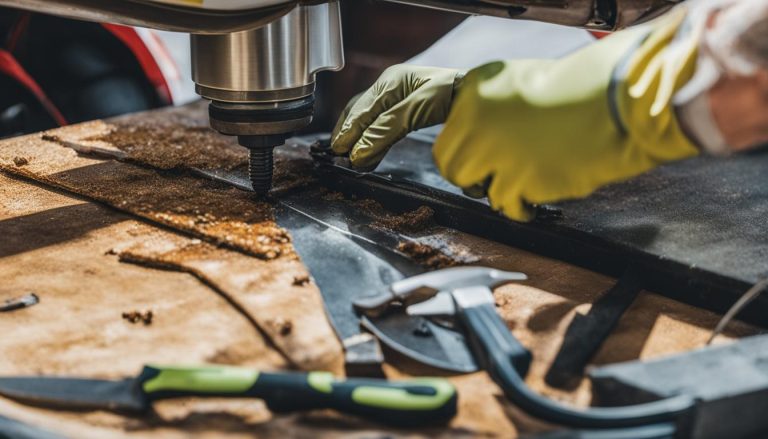Sanitize Your RV Water Tank: Easy Steps & Tips
gorvlifestyle.com and its partners may earn a commission if you purchase a product through one of our links
Sanitizing your RV water tank is an essential part of maintaining a clean and safe water supply while you’re on the road. Regular sanitization helps eliminate bacteria, mold, and mildew that can grow in the tank and water lines, ensuring that you and your family have access to fresh and healthy water throughout your travels. In this article, we’ll walk you through the easy steps and provide helpful tips for sanitizing your RV water tank.
Key Takeaways:
- Regularly sanitizing your RV water tank ensures a clean and safe water supply.
- Sanitization should be done every six months, but is especially important if there is a strange taste or smell in your water.
- Sanitizing your water tank eliminates bacteria, mold, and mildew that can grow in the tank and water lines.
- To sanitize your RV water tank, you’ll need bleach, a funnel, and clean water.
- Follow the step-by-step process to sanitize your water tank and maintain its cleanliness.
Why Sanitize Your RV Water Tank?
Sanitizing your RV water tank is crucial for maintaining water quality in your RV. When you fill your tank at different locations, the water may not always be clean. Additionally, bacteria, mold, and mildew can grow in the tank and water lines over time. By regularly sanitizing your water tank, you eliminate any potential contaminants and ensure that your family has access to safe and clean water while traveling. This simple maintenance task promotes the health and well-being of everyone onboard and allows you to enjoy your RV adventures worry-free.
Ensuring the cleanliness of your RV water tank through regular sanitization is essential for maintaining water quality. The water sources you encounter while on the road may not always be clean, and over time, harmful bacteria, mold, and mildew can grow in your tank and water lines. By regularly sanitizing your water tank, you eliminate these potential contaminants and set your mind at ease regarding the safety and cleanliness of your water supply. This simple task goes a long way in promoting the health and well-being of everyone on board your RV, allowing you to fully enjoy your adventures without any concerns.
Regular sanitization of your RV water tank is the key to maintaining water quality in your vehicle. By eliminating potential contaminants such as bacteria, mold, and mildew, you ensure that your family has access to safe and clean water while traveling. With a clean and sanitized water system, you can fully enjoy your RV trips without worrying about the quality of your water supply.
Take control of your water quality and prioritize the health and well-being of everyone onboard your RV. By sanitizing your water tank regularly, you can enjoy your travels with confidence, knowing that your water supply is safe and free from potential contaminants.
Benefits of Sanitizing Your RV Water Tank
- Ensures safe and clean water supply for drinking, cooking, and hygiene
- Eliminates bacteria, mold, and mildew that can grow in the tank and water lines
- Promotes the health and well-being of everyone onboard
- Prevents foul odors and strange tastes in your water
- Reduces the risk of waterborne illnesses
Investing a little time and effort into sanitizing your RV water tank can go a long way in ensuring a pleasant and worry-free travel experience. By maintaining water quality through regular sanitization, you can enjoy the comforts of home on the road without compromising the health and safety of your loved ones.
| Reasons to Sanitize Your RV Water Tank | Importance of Maintaining Water Quality | Benefits of RV Water Tank Sanitization |
|---|---|---|
| Water sources may not always be clean when filling your tank | Bacteria, mold, and mildew can grow in the tank and water lines over time | Ensures safe and clean water supply for drinking, cooking, and hygiene |
| Regular sanitization eliminates potential contaminants | Regular sanitization promotes the health and well-being of everyone onboard | Eliminates bacteria, mold, and mildew that can cause foul odors and strange tastes |
| Sanitization is an essential maintenance task for RV water tank | Sanitization reduces the risk of waterborne illnesses | Sanitization ensures a worry-free travel experience |
When to Sanitize Your RV Water Tank
Knowing when to sanitize your RV water tank is crucial for maintaining a clean and safe water supply during your travels. While regular sanitization should be part of your routine maintenance every six months, there are certain situations that require immediate attention. By being proactive and aware of these indicators, you can ensure that your water system remains clean and functional.
Signs Your Tank Needs Cleaning
- If you notice a strange taste or smell in your water, it’s a good indication that your tank needs cleaning. These odors and flavors can result from bacteria and other contaminants present in the tank.
- If your RV has been in storage for an extended period, it’s important to sanitize the water tank before using it again. Stagnant water can create an environment where bacteria and mold can thrive.
- Suspecting that the water used to fill your tank was not clean is another situation that calls for immediate sanitization. Whether you sourced the water from an untrusted supply or suspect contamination, it’s better to err on the side of caution and sanitize your tank.
Remember, the health and well-being of everyone onboard your RV depend on having a clean and safe water supply. By addressing these signs promptly, you can maintain peace of mind and enjoy worry-free travels.
To ensure the cleanliness of your RV water tank, it’s also essential to follow the best practices for sanitization. The next section will guide you through the step-by-step process of cleaning and maintaining your water tank.

What You Need to Sanitize Your RV Water Tank
Sanitizing your RV water tank is a crucial part of maintaining a clean and safe water supply for your travels. Luckily, the process is simple and requires minimal supplies. Here’s what you’ll need:
- Regular Bleach: Choose a non-scented bleach that is suitable for use in RV water systems. Bleach is effective in killing bacteria and eliminating contaminants in the tank.
- Funnel: Having a funnel makes it easier to add the bleach mixture to your water tank, ensuring accurate and efficient application.
- Clean Water Source: It’s important to use a clean and uncontaminated water source when filling your tank. This ensures that you’re not introducing any new contaminants during the sanitization process.
With these basic supplies ready, you can now proceed to sanitize your RV water tank and maintain its cleanliness. Follow the next section to learn how to perform the sanitization process step by step.

How to Sanitize Your RV Water Tank
Sanitizing your RV water tank is a straightforward process that can be done in a few easy steps to ensure a clean and safe water supply for your travels. Follow these simple instructions to sanitize your water tank and maintain its cleanliness:
-
Start by turning off the water heater and pump to prevent any damage.
-
Next, drain the entire fresh water system, including the water heater and low-point drains, to remove any remaining water.
-
Create a bleach mixture by following the appropriate ratio of bleach to water. Add this mixture to your fresh water tank.
-
Fill the tank with potable water, turn on the pump, and open each faucet one at a time to allow the bleach mixture to run through the system. This will disinfect the water lines as well.
-
Let the bleach sit in the tank for at least 24 hours to ensure that all bacteria and contaminants are eliminated.
-
Drain the tank and lines once again to remove the bleach mixture.
-
Finally, refill the tank with clean water and run the faucets until you no longer smell any traces of bleach. This will ensure that your water supply is completely clean.
By following these simple steps, you can easily sanitize your RV water tank and maintain a clean and safe water supply for your travels. Regular sanitization is essential to eliminate any bacteria, mold, or mildew that may be present, ensuring that you and your family have access to fresh and healthy water while on the road.
FAQ
How often should I sanitize my RV water tank?
It is recommended to sanitize your RV water tank every six months as part of your regular maintenance routine. However, certain situations may require immediate sanitization, such as if you notice a strange taste or smell in your water or if your RV has been in storage for a while.
What supplies do I need to sanitize my RV water tank?
To sanitize your RV water tank, you will need regular bleach (non-scented and suitable for use in RV water systems), a funnel for easy pouring, and a clean water source to fill the tank.
How do I sanitize my RV water tank?
The process of sanitizing your RV water tank involves turning off the water heater and pump, draining the entire fresh water system, creating a bleach mixture and adding it to the tank, filling the tank with potable water, running the bleach mixture through the system, letting the bleach sit for 24 hours, draining and refilling the tank with clean water, and running the faucets until no bleach smell remains.
Why is it important to sanitize my RV water tank?
Sanitizing your RV water tank is crucial for maintaining water quality and ensuring a clean and safe water supply while you’re on the road. It helps eliminate bacteria, mold, and mildew that can grow in the tank and water lines, promoting the health and well-being of everyone onboard.
When should I sanitize my RV water tank?
Sanitization should be done every six months as part of your regular maintenance routine. However, if you notice a strange taste or smell in your water or if your RV has been in storage for a while, immediate sanitization is necessary. Being proactive and aware of these indicators helps ensure that your water system remains clean and functional.






